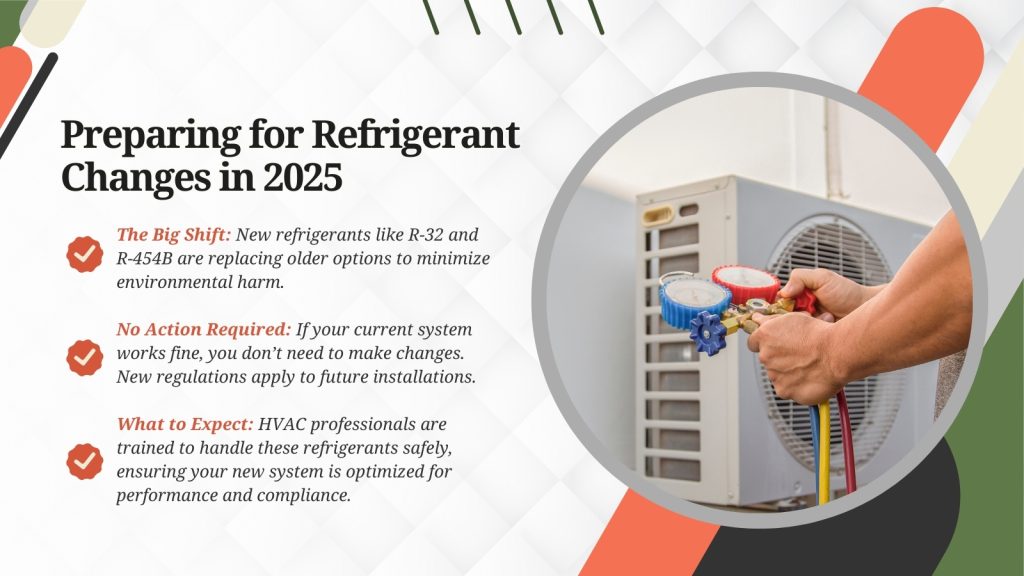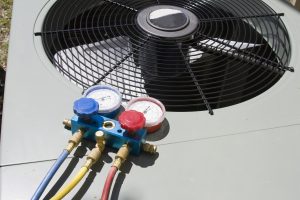As 2025 begins, the HVAC industry faces some changes to what kind of refrigerant gets used in both residential and commercial HVAC systems. The updates being made are part of a years-long goal in the U.S. to combat climate change and reduce our overall environmental impact when it comes to cooling systems.
The good news is, there’s nothing required on your part. If you have an existing system in place, it’s perfectly fine. If you’re planning to upgrade to a new HVAC system, our team will ensure that it meets all regulations–those already in place and new ones. Taking time to understand these refrigerant changes is a good idea so that you can make an educated decision, especially if you’re wondering what to look for in a new air conditioner.

Understanding the 2025 Refrigerant Shift
Refrigerant is an essential chemical that is used to cool down air in cooling systems like air conditioners and heat pumps. In a heat pump, refrigerant also helps to heat your home. Historically, refrigerants have had a high GWP, short for global warming potential. GWP measures the long-term impacts of something on our environment.
Refrigerants are safe as long as they are secure inside of HVAC system lines. But if any refrigerant leaks out due to line damage, it can hurt the environment. Refrigerants contribute significantly to greenhouse gas emissions that have the potential to damage our atmosphere.
As a result, the EPA, short for Environmental Protection Agency, is committed to incremental changes in a positive direction. Experts know that change may be gradual, and that’s why they set an end goal of 85% reduction by the year 2036. Another recent change to refrigerant happened in 2020. And now, five years later, we’re taking another step forward. t’s important to be aware of the dangers of leaking AC refrigerant as older systems may be more prone to these issues.
What the 2025 Refrigerant Regulation Means for You
The change being made is a move to more environmentally friendly refrigerant options. Examples include R-32, R-454B, and R-1234yf. We know that this is industry lingo a lot of people don’t fully understand, but we are happy to explain it in greater detail if you have additional questions. The bottom line is that these refrigerants are designed to meet the new 2025 regulatory standards and move us all a step forward in minimizing environmental impact.
Systems that are being manufactured and installed in 2025 will be optimized to utilize these new refrigerant options. Remember: there’s nothing you have to do. Your older system currently in place doesn’t require any refrigerant changes in the short term.
Our team is doing all the preparation to ensure we’re ready for these changes. Did you know that HVAC professionals like ourselves have to complete continuing education courses and earn new certifications? These refrigerant changes are just one example of why. Some of the updated refrigerants are flammable, meaning that we have to take extra care in handling the chemical.
Should You Upgrade Your HVAC System Before 2025?
If you need to upgrade in the near future, you can be confident that you’re selecting from the most up-to-date options. If you are interested in taking additional steps to lower your personal impact on the environment, a high-efficiency unit is the way to do that.
We can also talk to you about SEER2 ratings and how to choose an AC or heat pump that uses less electricity during operation–a great way to reduce your carbon footprint. Newer systems offer a range of benefits beyond refrigerant compatibility, including greater energy efficiency in modern central AC units.
Contact Snellville Heating, Air and Plumbing, where your comfort is OUR business. We’ll set you up right for 2025 with a new and improved heat pump system.




